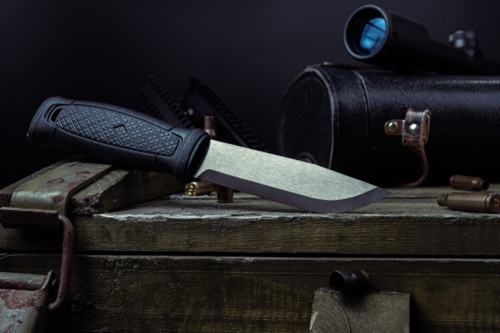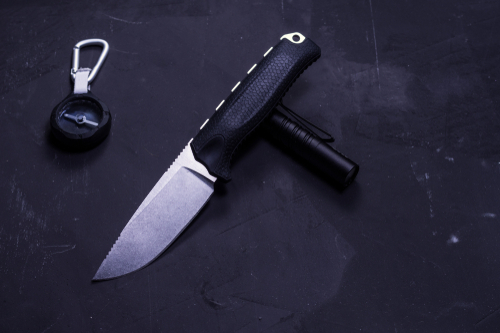How to Choose the Best Fixed Blade Knife for You: 8 Things to Consider
Nov 13th 2018

When it comes to urban and wilderness survival knives, nothing beats a fixed blade knife for strength and durability. Fixed blade knives are the perfect addition to your pack for any hunting or camping trip and can be used for an endless range of varied tasks beyond cutting. To determine the right fixed blade knife for your needs, consider these eight factors:
1. Primary Use
Most people purchase fixed blade knives for survival or tactical purposes where a strong, durable blade can be used as a multipurpose tool. However, fixed blade knives can also be used for urban applications such as in first response scenarios and cutting boxes.
If urban tasks are going to be the primary use for your knife, carefully consider the features of your knife to make sure it is legal to own and carry.
2. Length
The overall length of your fixed blade knife depends heavily on what tasks you intend to use it for. Long fixed blade knives are considered to be over 10 inches in length. These knives are best suited to more cumbersome tasks like splitting, chopping, and prying. Shorter knives under 10 inches are better for finer work like carving, cutting, or skinning game.
3. Weight
The weight can determine the heft and balance of the knife. This means that differently weighted knives are more suitable for various tasks. Heavier knives have more considerable heft and impart more force when hammering or prying. Lighter knives under 12 ounces work well for finer work and won’t fatigue the user so quickly.

4. Blade Style
Fixed blade knives come in a wide selection of blade styles that allow you to choose a knife best suited to your needs.
- Drop point knives have a wide belly and a gentle curve along the spine, making them a versatile all-round option.
- Serrated knives offer fast cutting action and typically hold their usable edge longer than other knives. Fixed blade knives are available with both fully and partially serrated blades.
- A tanto blade has a flat edge and a triangular point, which gives this type of blade superior piercing strength and is usually favored for military and tactical use.
- Clip point blades have a straight section that runs to the tip of the blade to give the user better control when cutting. It also has increased piercing strength. Clip point blades are a great flexible choice for a bushcraft knife.
- Chisel tip blades have a sharpened flat tip, which makes them ideal tools for digging, hammering, and prying.
5. Steel
The type of steel used in your fixed blade knife can determine how hard-wearing the blade will be and how long it holds its edge. For survival knives, look for corrosion-resistant steel such as Krupp 1.4116, VG10, and N690. If you need your knife to keep its edge longer during heavy-duty tasks, try harder steels such as M4 and ZDP-189.
6. Tang
The tang is the part of the knife blade that extends into the handle, and there are three types of tang, each with its benefits and drawbacks.
- Full tang extends the full length of the handle and is usually constructed from a single solid piece of metal that incorporates both the blade and tang. This gives full tang knives more strength, making them better for heavy-duty tasks such as butchering game, hammering, and prying.
- Partial tang knives have a tang that extends halfway down the handle. This is often done to reduce the weight of the knife and cut manufacturing costs. Partial tang knives are often cheaper to purchase, but there is an increased risk of breakage when used for heavy-duty tasks.
- Hollow handle knives are less robust than both full- and partial-tang knives, but the trade-off is you can store items inside the handle of your knife, such as fire starter, a first aid kit, or paracord.
7. Grip
Choose a handle that has a non-slip grip that allows you to hold the knife securely and comfortably to prevent fatigue and injury.
Grips come in a variety of materials, but, for most practical uses, modern materials such as carbon fiber, Zytel, micarta, and G10 are preferable, as they are more lightweight and durable than other types. Microtech fixed blades feature a D2 stainless blade and thumb ridge.
Grips should also feature an ergonomic design, which allows for exceptional handling in a range of positions and features a larger choil and guard or finger grooves for gripping with bare or gloved hands in all weather conditions.

8. Legal Restrictions
Some laws dictate where and how you can carry your fixed blade knife. Ownership and carry laws differ according to your state, so it is essential to check your state knife laws before purchasing a fixed blade knife. Consult local law enforcement for advice on complying with restrictions governing fixed blade knives if you are unsure of your local laws.
Final Word
Fixed blade knives are the perfect tool for urban, tactical, and survival tasks, but it is important to select the right style to suit your needs. For more information about fixed blade knives, or to check out the range of high-quality fixed blade knives we have available, call eKnives at (423)-525-9477.

